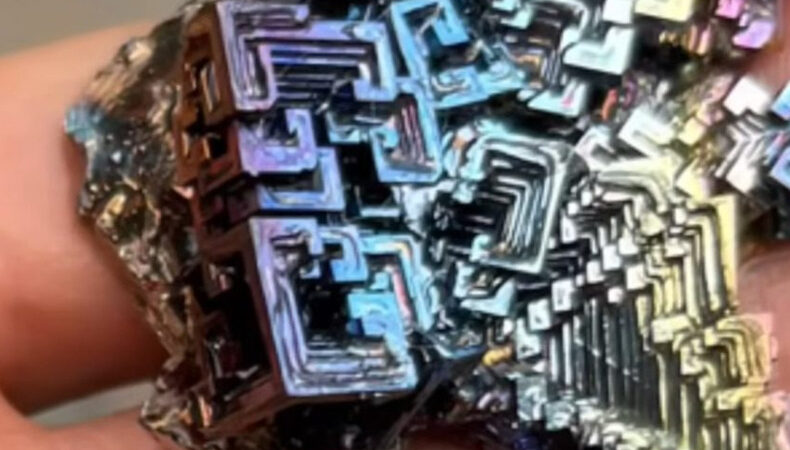
A Deep Dive into Molten Bismuth
Bismuth is known for a few notable characteristics: its low melting point, high density, and the mesmerizing psychedelic hopper crystals it forms. While diving into molten metal is never a good idea—regardless of how low the melting point might be—there’s a fascinating world beneath the surface worth exploring.
Recently, [Electron Impressions] posted a video titled “Why Do Bismuth Crystals Look Like That,” and it may be one of the most educational eight minutes on YouTube this week. The entire video is definitely worth watching, but since spoilers are the point of articles like this, here’s the secret: it all comes down to Free Energy.
No, not the “perpetual motion scam” version of free energy, but rather the concept of potential energy that chemical reactions aim to minimize. There’s energy involved in crystal formation, and nature tends to minimize the amount left unused—essentially trying to reach the lowest energy state possible.
When it comes to bismuth crystals—particularly when a pot of molten bismuth cools slowly at room temperature and pressure—you don’t end up with a simple, large rhombohedral crystal like you might expect if you’ve tried growing salt or sugar crystals in a beaker. Instead, you get the intricate, maze-like structure so characteristic of good bismuth crystals.
This unique shape arises because atoms preferentially deposit onto the vertices and edges of the growing crystal rather than the flat faces. As a result, more vertices and edges form, leading to the fractal spiral patterns bismuth crystals are famous for. Interestingly, this mechanism is similar to how tin whiskers grow—those pesky crystalline filaments found on some metal surfaces.
It’s important to note that bismuth isn’t actually unique in this behavior. Although [Electron Impressions] focuses specifically on bismuth, the principles explained in the video apply to other metals as well, given the right conditions. Hopper crystals have been produced in the lab from a variety of substances, including table salt and gold.
The key factor is the rate of cooling. If cooling is too rapid, atoms rush into the solid phase without respect for crystal structure, resulting in fine-grained, polycrystalline solids. However, if cooling is slow enough, the intrinsic crystal geometry can dominate, allowing hopper crystals to form. These crystals occupy a fascinating middle ground between rapid solidification and perfect crystal growth, creating those weird and delightful geometries.
In summary, hopper crystals are not only a beautiful natural phenomenon but also an excellent example of nature’s tendency to minimize free energy during crystallization. If you’re curious to learn more, the eight-minute video by [Electron Impressions] is definitely worth your time.
https://hackaday.com/2025/10/16/a-deep-dive-into-molten-bismuth/
You may also like
You may be interested
Clovis Police now using drones as ‘first responders’
**Clovis Police Department Introduces Drone First Responders to Enhance Public...
NASA is now a spy agency, thanks to Trump’s order
NASA Is Now a Spy Agency, Thanks to Trump’s Executive...
NASA is now a spy agency, thanks to Trump’s order
**NASA Is Now a Spy Agency, Thanks to Trump’s Order**...
 The New York Times
The New York Times
- On Trump’s Insults, Somalia’s Prime Minister Says ‘It’s Better Not to Respond’ 2025 年 12 月 3 日 Amelia Nierenberg and Hussein Mohamed
- A Drunk Raccoon Passed Out in the Bathroom of a Virginia Liquor Store 2025 年 12 月 3 日 Victor Mather
- Hong Kong’s Response to Deadly Fire Shows China’s Play Book in Action 2025 年 12 月 3 日 Li Yuan
- Shoppers Turn to Discounts and Debt, but Not Just for Holidays 2025 年 12 月 3 日 Emmett Lindner
- Ghislaine Maxwell Says She Will Ask a Court to Free Her From Prison 2025 年 12 月 3 日 Benjamin Weiser
- Trump Administration Begins Immigration Operation in New Orleans 2025 年 12 月 3 日 Eduardo Medina and Hamed Aleaziz
- Private Employers Cut Jobs in November, in Latest Sign of a Slowdown 2025 年 12 月 3 日 Ben Casselman
- With Tensions Rising, Israel and Lebanon Expand Cease-Fire Talks 2025 年 12 月 3 日 Euan Ward
- Cold Weather Forecast to Bring Chilliest Temperatures of the Season 2025 年 12 月 3 日 Amy Graff and Nazaneen Ghaffar
- What Tennessee Revealed About the G.O.P.’s Trump Trap in the Midterms 2025 年 12 月 3 日 Shane Goldmacher



Leave a Reply